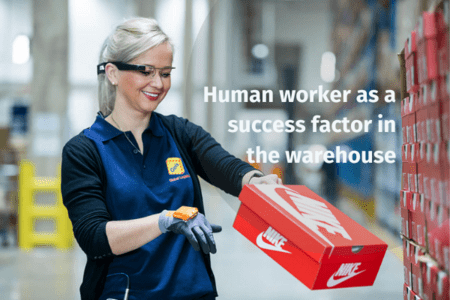Menu
There is no doubt that the work in logistics is changing in the face of digitization, automation and AI. However, a large part of the work in intralogistics will still be done by human workers in the future. Find out why and how companies can support their employees in the warehouse.

Although automation technologies are constantly evolving, a large part of the logistics industry still manages its warehouses manually – and that’s not likely to change very soon: It is becoming increasingly clear that human interaction with new technical solutions is the most efficient solution for many companies. In warehouse logistics in particular, people remain a key success factor: different products, changing customers and rapid scalability – the demands on logistics are high. And that makes full automation complicated and expensive. To remain competitive economically, new technologies in intralogistics must amortize quickly. This is one of the reasons why highly complex and cost-intensive solutions, such as picking robots, are still rare. Even in modern warehouses, people often remain the ones who assemble the goods and get them ready for shipment.
Manual picking still has unbeatable advantages, especially for portfolios with many different products. This is especially true in e-commerce warehouses, which rely on high flexibility and scalability with their wide range of items, small batch sizes, and seasonal and supply-related peaks. At the same time, not all processes can be automated today without immense investments. In eCommerce for example, return rates can go up to 70%. Every single triggers causes a costly and complex process. That’s why most companies continue to rely on human workers for this, too: Specially trained employees unpack returned goods, evaluate them and, if possible, put them back into storage.
In view of the major shortage of skilled workers, the biggest challenge for many logistics companies is finding employees. It is essential to support your current staff with smart assistant systems: This can make warehouse activities safer and more productive. Advanced assistant systems help to find the balance between automation and manual activities. One solution is the use of smart glasses: They reduce the warehouse worker’s cognitive load by providing visual and auditory support. Based on the process data generated while working, numerous processes in the warehouse can be optimized. These include, for example, shortening walking distances or arranging items in the warehouse so that bending and stretching movements are required less frequently. In addition to ergonomics, performance is also improved: numerous companies have already achieved productivity increases of up to 30% with smart glasses, for example in order picking.
The cognitive abilities of humans are still not replaceable. Humans and automated systems will coexist in the coming years. Companies benefit from this interaction through greater efficiency in their intralogistics. At the same time, they remain flexible and can adapt their processes to new circumstances within a very short time. In order to relieve the physical and mental burden on humans, the widespread use of intelligent assistant systems is recommended.